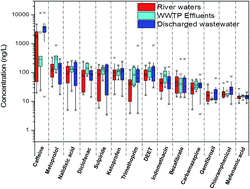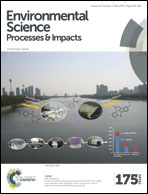Pharmaceuticals and personal care products (PPCPs) in urban and suburban rivers of Beijing, China: occurrence, source apportionment and potential ecological risk†
Abstract
This study analyzed 15 pharmaceuticals and personal care products (PPCPs) in two rivers with different urbanization levels in the surrounding watershed (urban and suburb) in Beijing, China. Along the rivers, effluent samples from wastewater treatment plants (WWTPs) and wastewater samples from direct discharge outlets were also collected to reveal their possible contribution to the occurrence of PPCPs in these two rivers. Among the 15 PPCPs, 14 compounds were detected with caffeine (maximum 11 900 ng L−1) being the dominant compound. The total concentration of the detected PPCPs in direct discharge outlets (median 4706 ng L−1) was much higher than that in river waters (2780 ng L−1) and WWTP effluents (1971 ng L−1). The suburban-influenced Liangshui River had significantly higher PPCP concentrations compared to the urban-influenced Qing River due to more input of untreated wastewater from direct discharge outlets. Source apportionment showed that approximately 55% of the total PPCPs were contributed by untreated wastewater in the suburban-influenced river. Finally, ecological risk assessment has been regarded as a necessary part of general research. According to the environmental risk assessment results, caffeine, trimethoprim and metoprolol were found to be the most critical compounds, due to their high risk quotient values. The results of the present study can provide useful information for future PPCP pollution control and sustainable water management in Beijing, China.


 Please wait while we load your content...
Please wait while we load your content...